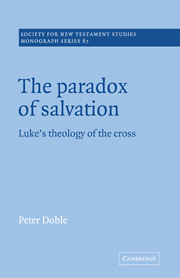Book contents
- Frontmatter
- Contents
- Preface
- List of abbreviations
- PART I Luke's theology of the cross: preliminary matters
- PART II Substantial matters: three distinctive elements at Luke 23.46, 47
- 2 Luke's use of δοξáζειν τòν Θεóν
- 3 Δíκαιος and ‘innocent’: Luke 23.47
- 4 Δίκαιος in Luke's Gospel
- 5 Δίκαιος as a christological descriptor: Acts
- 6 ‘Father, into thy hands …’
- PART III Echoes of Wisdom in Luke's theology of the cross
- Bibliography
- Index of biblical references
- Index of authors
2 - Luke's use of δοξáζειν τòν Θεóν
Published online by Cambridge University Press: 15 December 2009
- Frontmatter
- Contents
- Preface
- List of abbreviations
- PART I Luke's theology of the cross: preliminary matters
- PART II Substantial matters: three distinctive elements at Luke 23.46, 47
- 2 Luke's use of δοξáζειν τòν Θεóν
- 3 Δíκαιος and ‘innocent’: Luke 23.47
- 4 Δίκαιος in Luke's Gospel
- 5 Δίκαιος as a christological descriptor: Acts
- 6 ‘Father, into thy hands …’
- PART III Echoes of Wisdom in Luke's theology of the cross
- Bibliography
- Index of biblical references
- Index of authors
Summary
Luke's narrative of Jesus' death and its immediate sequel (Luke 23.47) places before his centurion's ‘confession’ of Jesus as δíκαιος, an enigmatic ἐδόξαζεν τόν θεόν. Why, as Hanson demanded, glorify God for the shameful death of an innocent man? This is certainly more than a ‘Lukan stock phrase’, but Franklin, while noting both that the phrase is significant for Luke and that its appearance at Luke 23.47 underlines the validity of the centurion's response, underestimated its peculiar force in Luke–Acts (1975, p. 62; cf. Stanton, 1974, pp. 35–9 and Marshall, 1970, p. 203).
This ‘peculiar force’ derives from a number of factors at work in each of the pericopae where the phrase appears. First, it signifies a worshipping response by people who have recognised God's presence at work in Jesus; perhaps this hint of ‘presence’ is why δοξάζειν rather than its synonyms is the verb used here, echoing δόξα with all its Septuagintal overtones. Second, the phrase is related to Luke's understanding of a scriptural plan of salvation so that wherever the phrase occurs it is accompanied by allusions to or reminiscences of scriptural passages. This feature echoes Luke's prologue where his work is described as a διήγησις περὶ τῶν πεπληροφορημένων ἐν ἡμῖν πραγμάτων.
- Type
- Chapter
- Information
- The Paradox of SalvationLuke's Theology of the Cross, pp. 25 - 69Publisher: Cambridge University PressPrint publication year: 1996



